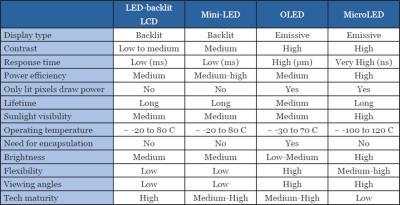MicroLED technology is a next-generation emissive display technology that promises highly efficient and bright displays that offer superior image quality with infinite contrast and a wide color gamut.
MicroLED can be applied to displays of many kinds - from small displays for smartwatches and AR devices to large-area TV displays. MicroLED displays are often compared to OLED displays - the main display technology that it is rivaling.
What is an OLED?
OLED is the current premium emissive display technology, already adopted in many mobile devices, wearables and even TVs. In 2023 over 800 million OLED displays shipped to companies such as Samsung, Apple, LG, Sony and others. OLEDs can be made flexible, foldable and even rollable and the displays offer the best image quality currently in production.
MicroLEDs vs OLEDs
OLEDs use tiny sub-pixels made from organic emissive materials. Micro-LEDs are somewhat similar - but with an inorganic LED structure. Compared to OLEDs, Micro-LEDs promise to be much more efficient and bright, more durable (higher lifetime) and with a higher color gamut, mostly due to the superior performance of LEDs over their organic counterparts.
The following table shows a comparison between OLEDs and MicroLEDs (it also details mini-LEDs and regular LCDs):
As can be seen, microLEDs has the potential to beat OLEDs in most metrics, including power consumption, lifetime, brightness, temperature range and response time.
The main drawback of MicroLED technology is that it is not mature yet, and there are still challenges on the way towards commercialization, as current production costs are extremely high. It is believed that within 3-5 years microLEDs will be able to compete with OLEDs in some early markets (mostly wearables, near-eye microdisplays and ultra large-area TVs), and in the long term microLEDs represent the future of the display industry.
The MicroLED and OLED Microdisplay Market Report updated to January 2021
MicroLED-Info is proud to announce an update to our MicroLED and OLED Microdisplays Market Report. This market report provides a great introduction to both MicroLED and OLED microdisplays, and covers everything you need to know about next-generation microdisplays. This is a great guide if you're considering to adopt microdisplays in your product and if you want to understand this industry better. The report is now updated to January 2021.
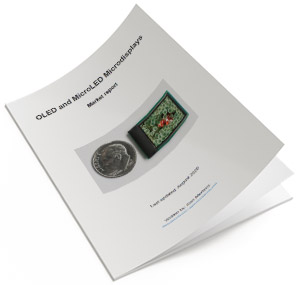
This market report covers everything you need to know about next-generation microdisplays. This is a great guide if you're considering to adopt microdisplays in your product and if you want to understand this industry better.
A discussion on MicroLED efficiency - microLED displays
This article is the second article in a short series of articles that discuss the efficiency of microLED displays. Our previous article discussed the quantum efficiency of microLED chips - with a conclusion that these can be quite efficient.
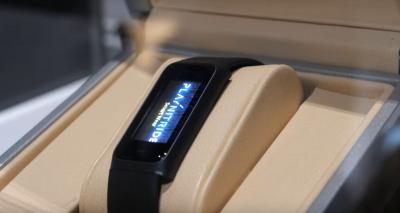
This article will look at the entire microLED display, and also compare it to current LCD and OLED displays. After all one of the main advantages of microLED displays is the increased efficiency (and brightness) compared to current displays. Most people assume that indeed microLEDs are much more efficient than OLEDs and LCDs.
Yole sees impressive growth for OLED and MicroLED microdisplays in the near future
Yole Développement (Yole) says that the microdisplay market is set for impressive growth in the next few years. By 2025, the total market will reach $4.2 billion in revenues (CAGR from 2020 to 2025 at 100%), while microdisplays for AR headsets will generate $1.8 billion.
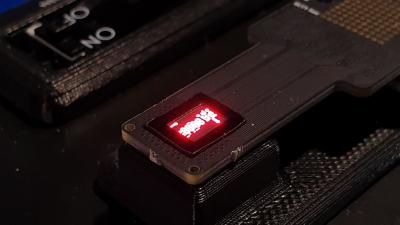
This optimistic forecast has a warning though - it all depends whether next-generation display technologies will deliver on their promises - and whether actual use-cases will be found and commercialized.
The MicroLED and OLED Microdisplay Market Report
MicroLED-Info is proud to announce a new market report, focused on MicroLED and OLED Microdisplays. This market report provides a great introduction to both MicroLED and OLED microdisplays, and covers everything you need to know about next-generation microdisplays. This is a great guide if you're considering to adopt microdisplays in your product and if you want to understand this industry better.

This market report covers everything you need to know about next-generation microdisplays. This is a great guide if you're considering to adopt microdisplays in your product and if you want to understand this industry better.
MicroLED Displays: Getting Ready for the Future?
This is a sponsored article by Dr Xiaoxi He, Principal Analyst, IDTechEx
MicroLED, believed by many to be the next generation of display technology, has been pursued by players of LED, display, OEM, materials and so on. Differentiated from LCD and OLED, microLED is considered to be the only display technology that has no size limitation. What are the potential applications? What are the hypes and realities? These are questions addressed in the brand-new IDTechEx report, “Micro-LED Displays 2020-2030: Technology, Commercialization, Opportunity, Market and Playersâ€.
Various Motivations Are Driving the Progress of MicroLED Displays
Samsung Display has announced it is ending the LCD business and will focus on its QD LCD & OLED businesses. LG Display has halted its domestic production of LCD panels. Korean vendors tend to reduce their LCD panel production and shift to QLED & OLED. In addition, Panasonic and JDI are also getting out of the LCD business. AUO, Innolux and a few other Taiwanese companies are slowing down investment in LCD or OLED. As a comparison, LCD manufacturing is shifting to mainland China due to cost competence, new line production efficiency and industry chain support.
InZiv Ships MicroLED Characterization Equipment
Israel-based display characterization and inspection equipment maker InZiv has recently announced the shipment of a high-resolution pixel characterization tool to an undisclosed Tier-1 consumer electronics company.
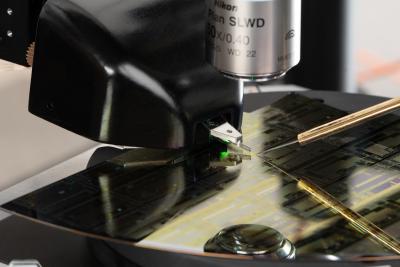
InZiv’s tool offers MicroLED defect detection on the wafer and pixel level with unprecedented sub-micron resolutions. Measuring luminescence, spectral wavelengths and 3D structure at the highest resolutions, the equipment enables the identification and the source of defects, accelerating product time to market.
RitDisplay announces it is shifting its focus from PMOLED to MicroLED displays
In May 2019 PMOLED display maker RiTDisplay announced a strategic partnership and share swap with MicroLED developer PlayNitride, and RiT later said it aims to release its first product to the market in 2020.

RiT announced today that its revenues for the year (to date) were $47.1 million USD - a decrease of 32.4% compared to last year. The company's CEO says that its PMOLED sales has been affected by e-cigarette bans in the US, and the company is now shifting its focus to develop micro LED displays (and also mini-LED ones).
Guangzhou's local government to subsidize emerging display technology production - including MicroLED displays
The local government of China's Guangzhou province announced that it now offers large subsidies (up to $285 million USD per company) to encourage emerging technology production in the province.

The government announced a list of emerging display technologies - which include OLEDs, quantum dot displays, e-paper displays, graphene enhanced display technologies - and microLED displays.
Mikro Mesa develops a cost-effective 4" RGB mass transfer process
Taiwan-based microLED developer Mikro Mesa announced that it achieved a breakthrough in its microLED transfer and bond process, which now enables the company to transfer 2-5 um microLED chips using a large 4-inch stamp.
![]()
Mikro Mesa's new process can transfer color (RGB) vertically-structured microLED chips and create a full-color display. It can be used to create high-density dipslays - up to 1,800 PPI and be used to create large microLED TVs, over 55-inch in size. The new process is a low temperature one (below 200 degrees Celsius) and can be used on flexible substrates - and be also used to create transparent displays.
AU Optronics to demonstrate a 12.1" LTPS Micro-LED display prototype
AU Optronics announced that it will demonstrate a 12.1" LTPS micro-LED display prototype next week that features a resolution of 1920x720 (169 PPI). It seems that this is the same display shown at IFA 2018.
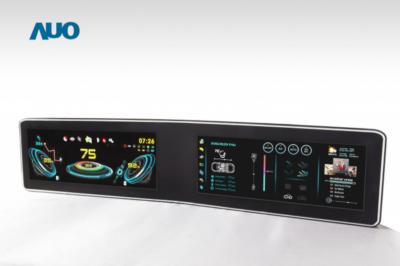
The 2018 display used blue LEDs with color conversion, which achieved "marvelous color performance", according to AUO.
Pagination
- Previous page
- Page 4
- Next page
